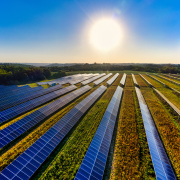AgriSolar News Roundup: Biosphere 2 Visit, Rooftop Agrivoltaics, New French Solar Canopy
AgriSolar Clearinghouse Visits Biosphere 2
“The AgriSolar Clearinghouse is taking a national tour of operational agrivoltaic operations, sharing knowledge, and bringing attention to a practice with numerous (and perhaps unexpected) benefits. The first stop on the tour is the agrivoltaic array at Biosphere 2, a research center run by the University of Arizona. Biosphere 2 is nothing short of incredible, it is a 3.14-acre laboratory in the middle of the hot, dry Sonoran Desert that is referred to as the world’s largest earth science experiment. Contained inside the massive facility is a climate-controlled environment, complete with ocean, rainforest, mangrove, desert, and savanna-simulating conditions.” – PV Magazine
Rooftop Agrivoltaics Shows Potential to Revolutionize Urban Farming
“Rooftop agrivoltaics have the potential to revolutionize urban farming. Just like the multifunctionality of agroforestry, which arguably revolutionized rural farming in the 1980s and 1990s, the multifunctionality of rooftop agrivoltaics can provide parallel co-benefits in urban spaces. Agroforestry has the co-benefits of growing food, sequestering carbon, and providing other ecosystem services in the same space – rooftop agrivoltaics is an urban analog. Although, rather than storing energy in the form of slow-growing biomass (wood), it harnesses the power of a rapidly renewable source – the sun.” – Live Architecture Monitor
New Agrivoltaic Solar Canopy Designed in France
French solar company TSE has released a new photovoltaic canopy for applications in agrivoltaic projects. The system features a rotating canopy that can host bifacial solar modules at a height of more than 5.5 meters. The canopy is placed on a four-post structure measuring 27 m x 12 m. “Our canopy is compatible with all agricultural machinery, including very large ones like combines, sprayers and spreaders,” the company’s president, Mathieu Debonnet, told pv magazine. The company said the canopy technology is particularly suitable for cereal farms that grow rapeseed, maize, barley, and vegetable protein, as well as sheep and cattle farms.” – PV Magazine



